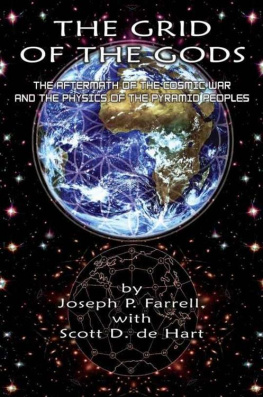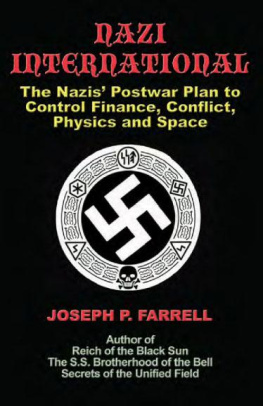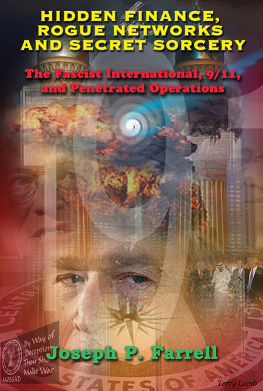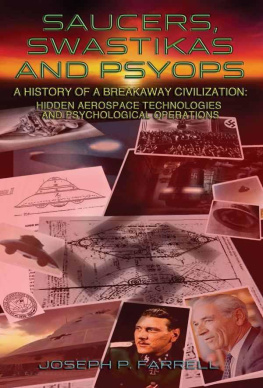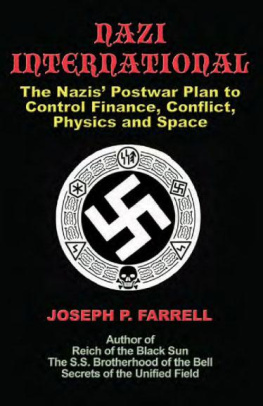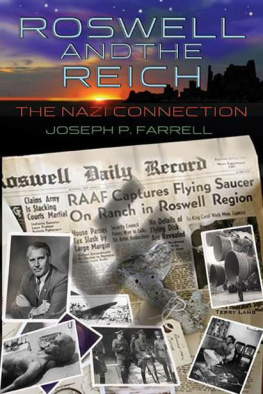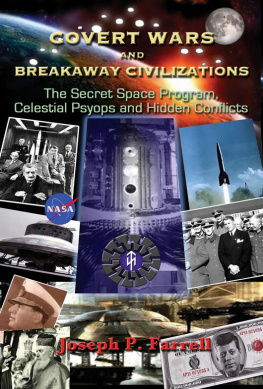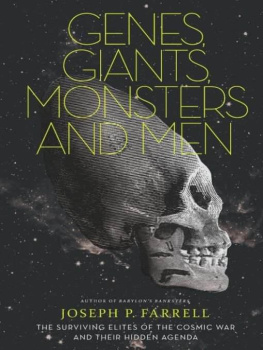Other Books by Joseph P. Farrell:
Nazi International
Thrice Great Hermettica and the Janus Age
Covert Wars and the Clash of Civilizations
Saucers, Swastikas and Psyops
Covert Wars and Breakaway Civilizations
LBJ and the Conspiracy to Kill Kennedy
Roswell and the Reich
Reich of the Black Sun
The S.S. Brotherhood of the Bell
Babylons Banksters
The Philosophers Stone
The Vipers of Venice
Secrets of the Unified Field
The Cosmic War
The Giza Death Star
The Giza Death Star Deployed
The Giza Death Star Destroyed
Transhumanism (with Scott deHart)
The Grid of the Gods (with Scott deHart)
The Third Way:
The Nazi International, European Union
and Corporate Fascism
by Joseph P. Farrell
Copyright 2015
All Rights Reserved
ISBN: 978-1-939149-48-0
Published by:
Adventures Unlimited Press
One Adventure Place
Kempton, Illinois 60946 USA
www.adventuresunlimitedpress.com
Cover by Joe Boyer
10 9 8 7 6 5 4 3 2 1
To My Friends: You are each a

To Scott Douglas deHart:
For conversations about beauty, music, poetry, and good things:
Thankyou is not enough;
To Catherine Austin Fitts,
Former Assistant Secretary of Housing and Urban Development during the administration of President George H.W. Bush, Who has been tireless in exposing the schemes of Mr. Global, For many stimulating conversations about the financial realities underwriting our age;
To Walter Bosley,
For many conversations and acts of friendship;
To My Many Readers
whose questions have inspired this book;
To George Ann Hughes,
For many comforting and encouraging hours of conversation: You have influenced so many for the better, and yours is a voice that will never be silenced;
Thank you, my friend, and God speed on your new journey;
And to
Tracy S. Fisher:
You are, and will always be, sorely missed.
Table of Contents
P ART O NE :
W ELTMACHT O DER U NTERGANG
P ART T WO :
E UROPE FROM THE A TLANTIC TO THE U RALS : C ARTELS , C URRENCY , AND N AZIS
P ART T HREE :
E UROPE FROM T HE A TLANTIC TO V LADIVOSTOK : T HE C OMMUNIST S IDE OF THE C OIN
P REFACE
The one duty we owe to history is to rewrite it. Oscar Wilde, The Critic as Artist
D OES THE N AZI I NTERNATIONAL STILL EXIST? I F SO , where is it located? Who are its members? What has it been up to? Ever since writing The Nazi International, people have been asking me these questions. Indeed, I have been asking them myself, and in other booksCovert Wars and Breakaway Civilizations and Covert Wars and the Clash of Civilizations I have been attempting to lay the groundwork necessary to answer that question. This book now attempts to do so directly. In point of fact, some of the material presented in this book I had gathered years ago when researching and writing The Nazi International, but I had decided not to incorporate it in that book, because that book was, as its title suggests, focused on the international extent of postwar Nazism and some of its activities.
But the answer to those questions is both disconcerting, and disconcertingly simple, for the answer is immediately implicated in any consideration of the August 1944 meeting of German industrialists and Nazi Party leaders at the Hotel Maison Rouge in Strasbourg, France. There the Nazi leadership and the German industrialists agreed to create a worldwide system of front companies, and a system of corporate-Nazi Party liaisons to maintain a covert coordination of Party and corporate interests and goals for postwar Germany and Europe. Careful consideration of the implications of the Hotel Maison Rouge meeting indicate that the principal field and center of action for the postwar extraterritorial state that I have called the Nazi International remained centered in Europe, and was concentrated into the centers of German corporate power. The Nazi International is a thus constellation of corporate relationships best characterized as cartels and trusts, behind which lurks an unreconstructed and unreformed Fascist ideology of the fusion of corporate and state power.
It is that fusion of corporate and state power that was really at the root of the Morgenthau Plan, brainchild of President Franklin Delano Roosevelts Secretary of the Treasury during World War Two, Henry Morgenthau Jr. For a period of a brief few months during the final stages of the war, the Morgenthau Plan became the official Allied policy for postwar Germany. Under the plan, the Reich was not merely to be occupied by the Allied Powers, but broken up into three or more independent states, and completely de-industrialized. There was a certain ineluctable logic to the idea, for only by the complete destruction of the massive German industrial plant could the power of the large German corporations and their hold and influence over the German state be broken. Morgenthaus Plan, while little more than a memorandum for revenge, did have another rationale, and that was that American experts were fully aware of what Germanys war aims in both World Wars was: the creation of a pan-European federation under German dominance and leadership, and therefore, under the dominance of the industrial-capitalists of the Rhine. It is the consistency of those aims, and the patterns and techniques used to pursue (and, it should be noted, ultimately achieve) them, that is the subject of this book, for as always, the devil is in the details.
The Morgenthau Plan was, however, dead almost as soon as the ink was dry on the surrender instruments signed at the end of World War Two by the German military, and for a very important reason: as will be seen in the main text, the Nazis had made it one of their chief aims and goals to liaise and utilize the pro-German sympathies of the American financial and corporate elite, a power structure in which they recognized their own Fascist ideology. The objective was to steer a careful course, a middle or third way between the Western and Communist blocs until such time as a European Reich could be created of sufficient economic power and military potential to be a counterbalancing force between the two blocs, and until such time as the rollback of the Communist bloc could be achieved. This third way was to be, as we shall see, neither the finance capitalism of the West, nor the state socialism of the East, but the finance-cartel capitalism and state socialism that became the hallmark of Imperial Germany, and remained as a fundamental structural feature of German domestic and international politics ever since.
The favored patterns and techniques of this power structure surveyed in this book thus concentrate on a number of areas:
1)The organization of the functions of the state around, and their integration in, cartel-like and trust-like corporate structures, which in their turn impose regulatory state bureaucracies by-passing legislative processes in favor of bureaucratic regulatory systems;
2)These structures in turn also incorporate the cartelization of currency into a German-dominated currency zone, which were definite war aims of the Nazis and their cartel allies. These aims were not only explicitly stated during World War Two, but detailed plans were made to implement them after the war. In the retrospective of history, the outcome of the war did not modify nor affect those plans, it merely delayed them;



